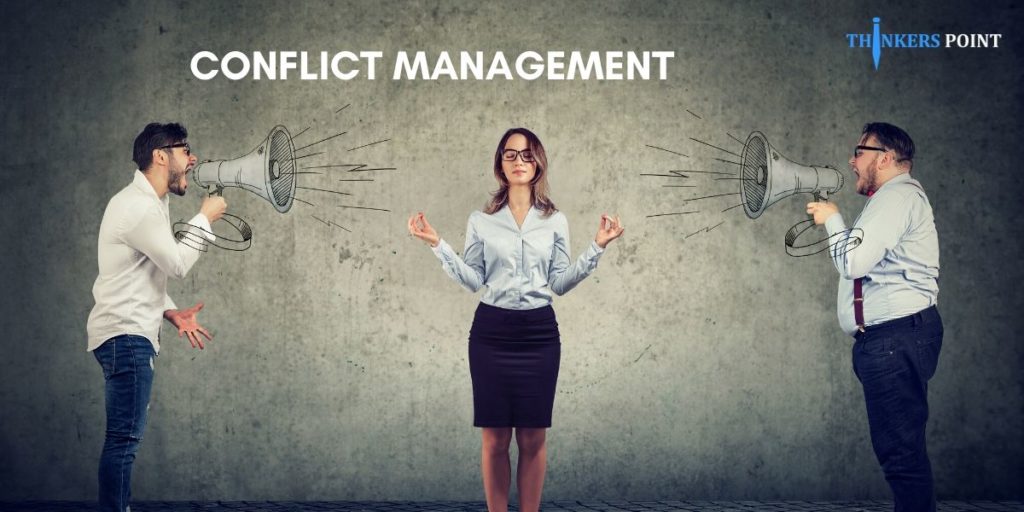Meaning Of Conflict Resolution
Conflict resolution is a conceptualize soft skill because of the methods and processes involved in facilitating the peaceful ending of conflict and retribution. Dedicated group members always try their best to solve group conflicts. They do so by actively communicating, sharing information about their conflicting motives to the remainder of the group (e.g., intentions and reasons for holding certain beliefs), and engaging in collective negotiation. Dimensions of resolution typically parallel the size of conflict within the way the conflict is processed.

1. Cognitive Resolution
Cognitive resolution is the way in which disputants understand analyze and examine the conflict, with beliefs, perspectives, understandings, and attitudes.
2. Emotional Resolution
Emotional resolution is within the way disputants feel a couple of conflicts, the emotional energy.
3. Behavioral Resolution
Behavioral resolution is reflective of how the disputants act, their behavior.
Ultimately a large range of methods and procedures for addressing conflict exist, including negotiation, mediation, mediation-arbitration, diplomacy, and artistic peacebuilding.
The term conflict resolution can be used interchangeably with the term ‘dispute resolution’, where arbitration and litigation processes are critically involved. The concept of conflict resolution is often thought to encompass the employment of nonviolent measures by conflicted parties in a trial to push the effective resolution.
Theories And Model Of Conflict Resolution
There is a plethora of various theories and models that link to the concept of conflict resolution.

1. Conflict Resolution Curve
There are many samples of conflict resolution in history, and there has been a debate about the ways to conflict resolution whether it should be forced or peaceful. Conflict resolution by peaceful means usually appears to be a higher option. The conflict resolution curve derived from an analytical model that provides a calm solution by motivating and appreciating conflicting entities. Forced resolution of conflict might invoke another conflict within the future.
The conflict resolution curve (CRC) separates conflict styles into two separate domains: the domain of competing entities and the domain of accommodating entities. There’s a kind of agreement between targets and aggressors on this curve. Their judgments of badness compared to goodness of every other are analogous on CRC. So, the arrival of all conflicting entities to some negotiable points on CRC is vital before peacebuilding. CRC doesn’t exist (i.e., singular) essentially if the prospect of aggression if the aggressor is definite. Under such circumstances, it would cause apocalypse with mutual destruction.
The curve explains why nonviolent struggles ultimately toppled repressive regimes from power and sometimes forced leaders to alter the character of governance. Also, this technique has been applied to capture the conflict styles on the Korean Peninsula and the dynamics of negotiation processes.
2. Dual Concern Model
According to the dual concern model, group members balance their concern for satisfying personal needs and interests with their concern for satisfying the wants and interests of others in numerous ways. The intersection of those two dimensions ultimately leads individuals to exhibit different types of conflict resolution. The twin model identifies five with number four being the target to finish the cycle and illuminate the difficulty at hand. Conflict resolution styles or strategies that individuals may use depend upon their dispositions toward pro-self or pro-social goals.
3. Avoidance Conflict Style
Characterized by joking, changing or avoiding the subject, or maybe denying that an issue exists, a strong dislike for following the foundations the conflict avoidance style is employed when a person has withdrawn in addressing the opposite party, when one is uncomfortable with conflict, or because of cultural contexts. During the conflict, these avoiders adopt a “wait and see” attitude, often allowing conflict to end on its own with none personal involvement. By neglecting to deal with high-conflict situations, avoiders risk allowing problems to fester or spin of control.
4. Yielding Conflict Style
In contrast, yielding, “obliging”, smoothing or suppression conflict styles are enhance by a high level of concern for others and an occasional level of concern for oneself. This pro-social passive approach comes forth when individuals derive personal satisfaction and happiness from meeting the requirements of others and have a general concern for maintaining stable, positive social relationships. When faced with conflict, a person with a yielding conflict style tends to harmonize into others’ demands out of respect for the social relationship.
5. Competitive Conflict Style
The competitive, “fighting” or pressurizing conflict way or style increases to maximum individual assertiveness (i.e., concern for self) and minimizes empathy (i.e., concern for others). Groups consisting of competitive members usually enjoy seeking domination over others. Fighters tend to force others to easily accept their personal views by employing competitive power tactics (arguments, insults, accusations, or maybe violence) that foster intimidation.
6. Conciliation Conflict Style
The conciliation conflict style is typical of people who possess an intermediate level of concern for both personal and others’ outcomes. Compromisers value business and, in doing so, anticipate agreed give-and-take interactions. This conflict style is often consider as an extension of both “yielding” and “cooperative” strategies.
7. Cooperation Conflict Style
Characterized by an energetic concern for both pro-social and pro-self behaviour, the cooperation, integration, confrontation, or problem-solving conflict style is usually used when a private has elevated interests within their own outcomes moreover as in the outcomes of others. During the conflict, cooperators collaborate with others in an attempt to seek out an amicable solution that satisfies all parties involved in the conflict. Individuals using this sort of conflict style tend to be both highly assertive and highly empathetic. By seeing conflict as an ingenious opportunity, collaborators willingly invest time and resources into finding a “win-win” solution. In line with the literature on conflict resolution, a cooperative conflict resolution style is usually recommended specifically others. This resolution could also be achieved by lowering the aggressor’s guard while raising the ego.
8. Relational Dialectics Theory (RDT)
RDT, introduced by Leslie Baxter and Barbara Matgomery (1988), explores the ways within which people in relationships use verbal communication to manage conflict and contradiction as critical psychology. This idea focuses on maintaining a relationship even through contradictions that arise and the way relationships are managed through coordinated talk. RDT assumes that relationships are composed of opposing tendencies, are constantly changing, and tensions arise from intimate relationships.
Concepts

1. Contradictions
The concept is that the contrary has the characteristics of its opposite. People can seek to be during a relationship but still need their space.
2. Totality
The totality comes when the opposites unite. Thus, the link is balanced with contradictions and only then it reaches totality
3. Process
Comprehended through various social processes. These processes simultaneously continue within a relationship in an exceedingly recurring manner.
Process Of Conflict Resolution

The resolution of conflicts in the workplace typically involves some of the following processes:-
- Recognition by the parties involved that an issue exists.
- Mutual agreement to handle the problem and find some resolution.
- An effort to grasp the angle and concerns of the opposing individual or group.
- Identifying changes in attitude, behavior, and approaches to figure by each side that may lessen negative feelings.
- Recognizing triggers to episodes of conflict.
- Interventions by third parties like Human Resources representatives or higher-level managers to mediate.
- A willingness by one or both parties to compromise.
- Agreement on a thought to deal with differences.
- Monitoring the impact of any agreements for change.
- Disciplining or terminating employees who resist efforts to defuse conflicts
Conflict Resolution In The Workplace
According to the Cambridge dictionary, an awfully basic definition of CONFLICT is full of life disagreement between people with opposing opinions or principles. Conflicts like disagreements may occur at any moment, being a standard a part of human interactions.

The sort of conflict and its severity may vary both in content and degree of seriousness; however, it’s impossible to completely avoid it. Actually, conflict in itself isn’t necessarily a negative thing. When handled constructively it can help people to face up for themselves to evolve and find out how to figure together to realize a mutually satisfactory solution. But if the conflict is handled poorly it can cause anger, hurt, divisiveness, and more serious problems.
Conflict can be avoided?

If it’s impossible to completely avoid conflict because it was said, the probabilities to experience it are usually higher particularly in complex social contexts within which important diversities are at stake. Especially due to this reason, speaking about conflict resolution becomes fundamental in ethnically diverse and multicultural work environments, within which not only “regular” work disagreements may occur but within which also different languages, worldviews, lifestyles, and ultimately value differences may diverge.
Conflict Resolution is a process by which two or more parties engaged during a disagreement and reach an agreement solving it. It involves a series of stages, involved actors, models, and approaches that will rely upon the sort of confrontation at stake and therefore the surrounded social and cultural context. However, there are some general actions and private skills that will be very useful when facing a conflict to unravel (independently of its nature)
Example: an open-minded orientation able to analyze the various point of view and perspectives involved, in addition to the capability to empathize, carefully listen, and clearly communicate with all the parts involved.
Sources of Conflict in Workplace

Sources of conflict are also numerous, counting on the actual situation and also the specific context, but a number of the foremost common include:
Personal differences like values, ethics, personalities, age, education, gender, socioeconomic status, cultural background, temperament, health, religion, dogmas, etc. Thus, any social category that serves different people may become an object of conflict when it does negatively diverge with people that don’t share clashes of ideas, choices, or actions.
Conflict occurs when people don’t share common goals or common ways to achieve a specific objective (e.g. different work styles). Conflict occurs also when there’s direct or indirect competition between people or when someone may feel excluded from a specific activity or by some people within the corporate. Lack of communication or poor communication is a significant reason to start out a conflict, to misunderstand a specific situation, and to form potentially explosive interactions.
Frequently Asked Questions-
Ans. a) Avoiding: Someone who uses a strategy of “avoiding” mostly tries to ignore or sidestep the conflict, hoping it will resolve itself or dissipate.
b) Accommodating
c) Compromising
d) Competing
e) Collaborating
Ans. Having good conflict resolution skills help employees to reduce the friction that may damage their working relationships. By resolving conflicts in a very more professional and respectful manner, they’re enabled to collaborate better with co-workers, building stronger work relationships. Reduced disruptions.
Ans. a) Communication: Employees must understand how to speak to every other so as to grasp the source of conflict, additionally as alternate points of view but communicating well involves over talking and getting your point across to others.
b) Problem-Solving
c) Stress Management
d) Emotional Agility
Ans. There are two forms of conflict in literature:
Internal conflict is within the character’s mind. Internal conflict is described as a struggle between opposing forces of desire or emotions within someone.
External may be a conflict between a personality and an out of doors forces.
Ans. a) Poor communication: Communication relies on clear and complete messages being sent moreover as being received.
b) Misunderstandings
c) Lack of designing
d) Poor staff selection
e) Frustration or stress
f) Burnout


Pingback: Interpersonal Communication Skills | ThinkersPoint